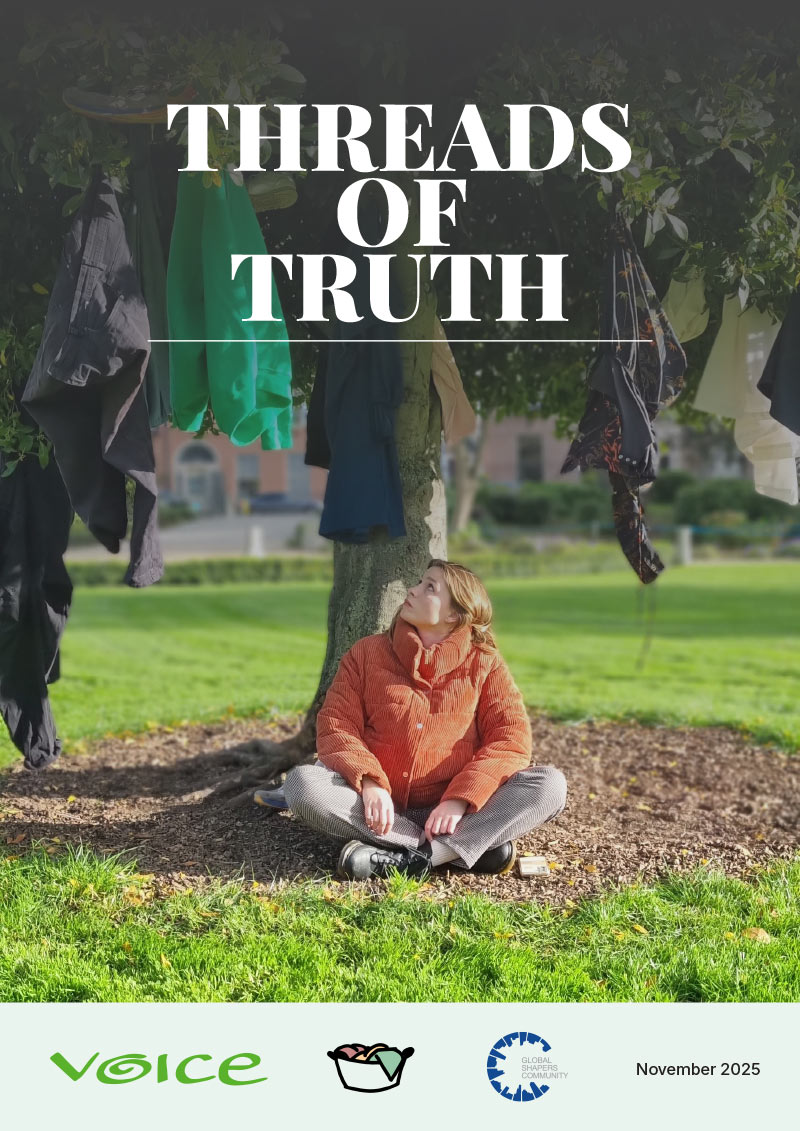New investigation finds that 95% of Irish-donated clothes are exported abroad!

Ever dropped clothes into a bring bank or shop take-back bin and wondered what really happens next? Most of us assume our these will go to local groups and be reused or recycled here. But the reality is far less straightforward. Where does that pair of jeans actually go? Why is Ireland’s textile recycling system still so opaque?
Threads of Truth, a new investigation by VOICE Ireland and the Dublin Hub of the Global Shapers, set out to find answers. Placing trackers in 23 donated items, our team uncovered a hidden global journey: 95% of items were exported out of Ireland, and 60% left the EU entirely. Only 26% were actually reused.
Over ten months, these clothes travelled through 12 countries: from Poland to Pakistan, the UAE to Libya. We are exposing a complex, largely invisible trade that can have many unwanted consequences.
Threads of Transparency:
Understand the Issue.
Have you ever wondered what happens to your clothes once they leave your closet? The journey of our garments doesn't end when we discard them. In fact, it's just the continuity of the many impacts that the fashion industry has on our environment. Welcome to the world of post-consumer textiles – a term that might be unfamiliar to many but holds the key to understanding the fate of our discarded clothes.
So, what are post-consumer textiles?
Post-consumer textiles, or PCT, refer to the clothes we wear that eventually find their way into the waste stream. Think about it: that shirt you wore last year, those jeans you've outgrown, or that sweater with a minor snag – they ALL become part of the post-consumer textile cycle, when we decide they're no longer suitable for us.
But here's where the plot thickens – these discarded clothes journey through a complex system that can have profound consequences for our environment.
How we dispose of textiles in Ireland?
In Ireland, a staggering amount of post-consumer textiles end up discarded each year. On average, each person discards around 35 kilograms of clothing annually.
That's like throwing away two entire suitcases of clothes!
And what's more concerning is that a whopping 65% of these discarded textiles are directly treated as waste, finding their way to landfills or incineration. This unsustainable disposal practice comes with a heavy toll on the environment, contributing to pollution and resource depletion.
What are the missing pieces of the puzzle?
The situation becomes even more perplexing when we examine the lack of transparency surrounding the 35% of post-consumer textiles that is being collected. Ever wondered where your discarded clothes actually go when you stuff them into one of these bring banks?
This is where the puzzle gets tricky. Ireland's textile landscape is a mix of various collectors and pathways – municipal collection, charities, and commercial collectors. Unfortunately, there's a shortage of information about what happens after you drop your clothes into a collection bin. Are they truly reused, recycled, or just exported elsewhere?
Well, aside from the garments that find new homes through our widespread network of charity shops, the majority are likely being sent down an intricate supply chain. Unfortunately, textiles of lowest quality (waste), are likely ending up as solid waste in receiving countries. This contributes to blockages in rivers, green spaces, and parks, predominantly in regions of the global south, thereby exacerbating environmental and health challenges for those communities tasked with managing our discarded materials.

At VOICE, we believe this situation is unacceptable when 47%1 of our population is most often managing unwanted clothes through bring banks.
1 EPA: Textiles: attitudes & behaviours national survey 2021
It's time to question the fate of our garments and demand transparency.
By understanding the significance of post-consumer textiles, we can make ask for better options that resonate with sustainability. Every piece of clothing we discard is a potential resource that can be repurposed, recycled, or reused. But for that to happen, we need a collective effort to hold collectors accountable and ensure that discarded clothes are managed responsibly.

The Way Forward: Demanding Transparency and Change.
Through our Threads of Transparency position paper on the fate of Irish Textile waste, we demand transparency in the post-consumer textile sector, pushing for clearer definitions, regulations, and better management practices. This has the potential to create economic opportunities by fostering national sorting facilities dedicated to improving reuse and recycling practices.
Ireland has the opportunity to lead the change towards a future where discarded clothing doesn't meet a dead end, but rather serves as a gateway to circularity and sustainability. You can be a part of this transformative journey by taking a simple yet impactful step: share our policy paper with your local authority. As the default entity in charge textile collection and management, they must step up and take action to give people options that won’t lead to landfill, incineration or export. With the appropriate support from the government, your call to action could be the catalyst for positive change.
To learn more about the impacts of low quality textiles on receiving countries you can watch this video from the EEB (European Environmental Bureau).





